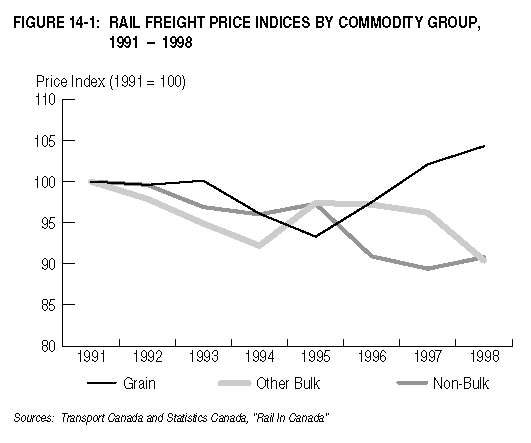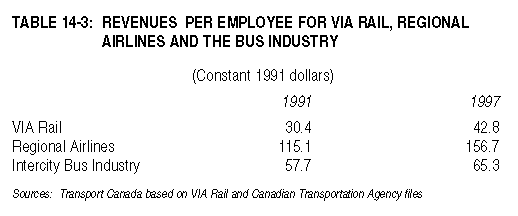14
PRICE, PRODUCTIVITY AND FINANCIAL PERFORMANCE IN THE
TRANSPORTATION SECTOR
Rail Industry
The Freight Rail Industry
Freight railways in Canada generate a total of $7 billion in
revenues annually. Of this, the two mainline railways combined
account for 90 per cent, while the regional/short line railways
account for the remaining ten per cent.
This report focuses on the performance of Canadian National
and Canadian Pacific Railways' Canadian operations, although the
financial analysis does include a brief discussion of the
performance of regional/shortline railways.
Output and Price Changes
In the first three quarters of 1999, CN and CPR's rail freight
output increased by 3.6 per cent over the same period in 1998.
This was due to the recovery of grain traffic and growth in intermodal,
automotive and forest products. Between 1991 and 1998, the average
annual growth rate of railway output was about two per cent.
Rail service prices stayed at their 1997 level in 1998, but declined
by four per cent in the first nine months of 1999. In 1998, the
average rail price was seven per cent lower than in 1991, an indication
that shippers received some of the benefits in productivity gain
that the railways had achieved. Since 1991, the price performance
of the two mainline railways has allowed rail freight costs
of shippers to be reduced by an estimated $1.1 billion. This is equivalent
to a 17 per cent reduction in their rail freight bills between
1991 and 1998.
By commodity groups, however, freight prices have fluctuated,
reflecting commodity-specific market factors. Figure 14-1 compares
changes in rail freight prices for selected commodity groups from
1991 to 1998: grain, bulk (primary commodities, except grain)
and non-bulk (including semi-fabricated products, finished goods
and intermodal). It shows that the average rail freight rate of
grains has increased by ten per cent since 1995. Because of significant
declines in 1994 and 1995, however, the average grain freight
rate in 1998 was only two per cent higher than in 1991. Freight
rates of other bulk and non-bulk commodities are lower than 1991
levels.

Cost Structure
The total cost of Canadian rail freight operations can be broken
down into variable costs and capital or fixed costs. In 1998,
variable costs, such as labour, fuel, and other materials and
services accounted for 73 per cent of total costs; capital
or fixed costs, including depreciation and leasing expenses, debt
costs and return to equity, accounted for the remaining 27
per cent.
Railway labour costs, as a percentage of total costs, declined
from 40 per cent to 36 per cent between 1991 and 1998. Increases
in costs of other materials and purchased services exceeded the
drop in the labour cost share. The share of fuel cost remained
stable at around eight per cent of total costs. The capital
cost share was lower in 1998 than in 1991 because of lower interest
rates.
Cost and Productivity Indicators
Following strong productivity growth in 1996 and 1997, CN and
CPR continued to show significant productivity gains in 1998.
The upward trend was primarily due to more efficient use
of variable inputs. The variable factor productivity, which compares
output growth with the growth of aggregate non-capital inputs
such as labour, fuel and materials, increased by 6.6 per cent
in 1998. Labour was the main contributor to total productivity
growth of the Class I freight railways in 1997, but was surpassed
by greater efficiency in fuel use and material inputs in 1998.
Over the past decade, labour productivity improvements in the
rail industry have been achieved mostly through workforce reductions.Note
2 The two mainline freight railways have, in recent
years, pursued further workforce restructuring plans. For instance,
in 1998-1999, CN reduced its workforce by 3,000 and CPR announced
a job reduction plan in the second quarter that affected
1,900 employees.
The partial productivity of capital inputs declined by 3.8 per
cent in 1998 from 1997. This was partly attributable to a large
amount of railway investment in new locomotives and rolling
stock, but was somewhat moderated by productivity gains in variable
inputs.
Total factor productivity of Class I railways increased by 3.5
per cent in 1998. Since 1991, it has improved by 27 per cent.
The unit cost curve of railways has shown a downward trend
since 1991, with an average annual rate of reduction of 2.7 per
cent. Lower unit costs have allowed both CN and CPR to offer
competitive prices and improve their financial performance at
the same time. With 1991 as the base year, productivity performance
has allowed the rail industry to achieve total costs in 1998
that are $2.1 billion lower than they would have been without
the productivity improvement. These savings are significant, as they
represent 32 per cent of the industry cost base.
Financial Performance
In recent years, long-term benefits from productivity gains
have allowed the rail industry to substantially improve their
profitability. The Canadian operations of CN and CPR continued
to show improved financial performance in 1999, based on results
from the first nine months. Excluding special charges, their
average operating ratio was at 79 per cent, a three per cent improvement
over the same period in 1998. Both CN and CPR reported record
fourth quarter financial results on a system consolidated
basis.
Table 14-2 shows the financial results of the rail freight
industry's Class I and regional/shortline railways.

Total freight revenues declined by five per cent in 1998. Despite
this, however, the 1998 average operating ratio of CN and CPR
in Canadian operations was reduced to 82 per cent, from
84 per cent in 1997, reflecting major cost reduction efforts.
Total combined operating income of CN and CPR rose to $1.1
billion (excluding special charges) in 1998, up by three
per cent from 1997.
To facilitate yearly comparisons, extraordinary items are excluded,
but they are noted for their significant amounts. CN took a special
charge of $590 million in 1998, while
CPR incurred special charges of $501 million in the second quarter
of 1999, both related to workforce reductions. While these reductions
are system-wide, most have been carried out in Canadian operations.
With the purchase of Illinois Central Railways in the US, the
Canadian operation of CN now represents about 68 per cent
of total CN North America in percentage of total system revenues.
CPR revenues from Canadian operations represent 73 per cent of
its total system revenues.
Regional railways also benefited from a strong Canadian economy
in 1998. That same year, Class II railways' total revenues and
expenses were $744 million and $644 million, respectively.
Compared with 1997, revenues increased by 2.3 per cent and expenses
remained at close to the same level. Operating ratios improved
from 89 per cent in 1997 to 87 per cent in 1998. The revenue growth
in 1998 was partly attributable to new shortline railways, which
started up in late 1997 and in 1998. These railways primarily
serve local rail freight markets.
VIA Rail
VIA Rail generated operating revenues of $217 million in 1999,
an increase of ten per cent from the same period in 1998,
with strong growth in the Quebec-Ontario corridor and the west.
Output and Price Changes
Since 1991, VIA Rail has achieved notable growth in operating
revenues mainly through price increases. This trend continued
in 1998 as VIA Rail's aggregate prices climbed by 7.2 per cent
while output declined by 2.4 per cent.
From 1991 to 1998, the price of rail passenger services increased
on average by 4.8 per cent a year, a rate that exceeded the overall
inflation trend. These price increases have meant that VIA Rail's
passengers contributed $37 million to the reduction of its
operating deficits. Rail passenger service demand was up
in the mid-1990s, especially for long haul services, but the different
rail passenger markets either became stagnant or declined in the
last two years. As a result, VIA Rail's output in 1998 was
about 0.2 per cent lower than in 1991.
By market, the long haul services recorded the strongest price
increases, with an average of seven per cent a year from 1991
to 1998. Over the same period, prices within the corridor
services showed an average increase of four per cent
a year, whereas remote regional services faced more modest price
increases of 2.9 per cent a year.
Cost Structure
VIA Rail's total costs are made up of variable costs (79 per
cent) and capital costs (21 per cent). Total variable costs can
be broken down into labour, fuel, marketing, payments to carriers,
and other materials and services. There have been no significant
changes in VIA Rail's cost structure from 1991 to 1998.
In 1998, labour remained VIA Rail's largest cost component,
representing 39 per cent of its total costs. In dollar terms,
total labour costs are about equivalent to VIA Rail's total
passenger revenues. Fuel costs declined during 1998 to 3.6 per
cent of total costs as a result of lower fuel prices.
Marketing costs (promotion and commissions to ticket agents)
accounted for six per cent of total costs and correspond to 14
per cent of VIA Rail's passenger revenues. Payments to carriers
represented 12 per cent of VIA Rail's costs. The remaining
variable costs consist of non-income taxes (three per cent) and
a residual category accounting for 17 per cent of VIA Rail's
costs.
VIA Rail's capital cost share, including the estimated opportunity
cost of its capital, is the third highest in the transport sector,
after that of CN and CPR and transit systems.
Cost and Productivity Indicators
VIA Rail's total factor productivity increased by 32 per cent
between 1991 and 1998, with most productivity gains achieved in
1994 and 1995. This robust productivity performance has allowed
it to reduce its costs in nominal terms by $117 million since
1991, which was equivalent to 73 per cent of the subsidy
reduction. In real terms, the cost reduction is $172 million,
or 36 per cent of VIA Rail's cost base.
Labour, fuel, services supplied by CN and CPR, and other materials
and services are combined as one "variable" factor of
production of rail passenger services. This eliminates substitution
effects between these factors. During the 1991 - 1998 period,
the productivity of this variable factor increased on average
by 3.5 per cent a year.
Labour productivity at VIA Rail grew on average by an impressive
four per cent a year, despite a decline in 1998. The productivity
levels of VIA Rail can be compared with those of other transport
sectors in more than one way. As Table 14-3 shows, when
revenues per employee, in constant dollars, are used as the basis
of comparison, the employees of regional airlines affiliated with
Air Canada and Canadian Airlines International produced 3.7 times
more revenues than VIA Rail employees in 1997. Intercity bus employees
generated 53 per cent more revenues. These comparisons suggest
that the strong growth of VIA Rail's labour productivity may have
resulted from untapped productivity slack.

Financial Performance
VIA Rail received $167 million in operating subsidies in 1998,
only about half of the amount it received in 1991. Its cost recovery
ratio, with the cost of capital accounted for, rose from 24 per
cent to 41 per cent in the same period, as shown in Table 14-4.

From 1991 to 1997 inclusively, VIA Rail was able to maintain
a positive cash flow position. This was not the case, however,
in 1998. With the reduction in government funding in 1998, the
carrier has had to draw about $15 million from its Asset
Renewal Fund to cover its cash shortage for its operating
expenses.
Rail Industry
NOTES:
2
In this report, an adjustment was made to historical labour input
quantities in order to be in accord with the railways' amortisation
schedules of special charges related to workforce reduction. The
adjustment has an impact on the annual labour and total factor
productivity estimations from 1992 to 1997, but it does not change
the overall conclusion that Canadian railways have had significant
labour productivity and total productivity gains over this period.
|

